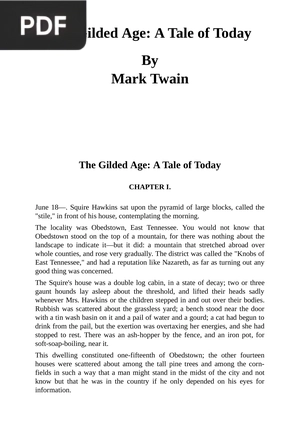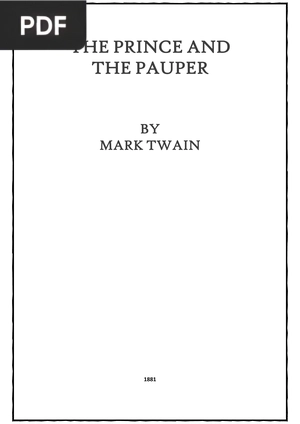The Innocents Abroad
Author: Mark Twain
*Wait a few seconds for the document to load, the time may vary depending on your internet connection. If you prefer, you can download the file by clicking on the link below.
Information
Description: <p>In 1867, the first modern tourist excursion of the time departed from the port of New York, bound for the most classic sites of the Mediterranean. Twain embarked on this excursion, armed with his sharp humor and his distinctive command of language, with the idea of sending chronicles of his trip to the newspaper that sponsored his trip, the Alta California.</p> <p><strong>In The Innocents Abroad</strong>, Twain talks about himself, the old masters, Michelangelo, the Neapolitan or French tour guides, and the Pilgrims and their journey to the Holy Land.</p> <p>Two years later the book was edited with Mark’s notes, which achieved great success since it was used by Americans as a travel guide.</p>
Pages: 486
Megabytes: 3.65 MB
This may interest you
The Gilded Age: A Tale of Today
Extension: PDF | 334 pages
<p>It is the only novel Twain wrote in collaboration with another writer, his good friend Charles Dudley Warner, who was also an editor. It is known that Mark wrote the first 11 chapters, followed by 12 chapters written by Charles. The next were written by only one of them, and the last few are attributed to joint authorship.</p> <p><strong>The Gilded Age</strong> was completed between February and April 1873 and was first published that same year. At that time its title became synonymous with materialism, greed and corruption.</p> <p>The story is set in Washington, D.C., and satirizes the corruption of the ruling class, whose plot revolves around their desire to enrich themselves through speculation, a theme that is still relevant in today’s society even though more than a century has passed since the work’s publication.</p>
The Adventures of Tom Sawyer
Extension: PDF | 105 pages
<p>In this work Twain relives his childhood and his adolescent days combining them with fiction. The story is a tale for children full of adventures where the little ones are the heroes, but the novel also includes a direct and clear message for adults.</p> <p><strong>The Adventures of Tom Sawyer</strong> spans a few months in the life of Tom, who lives on the banks of the Mississippi River and is raised by his Aunt Polly. Although his aunt loves him sincerely, she also subjects him to unpleasant and even absurd discipline.</p> <p>Tom has a different perspective of the world from how adults see it, which is why his reactions to his elders are so amusing. His friend Huckleberry Finn is even more rebellious and wild than Tom, making him the ideal companion for him.</p>
A Tramp Abroad
Extension: PDF | 420 pages
<p><strong>A Tramp Abroad</strong> is a work of travel literature published in 1880. In it Mark included facts lived and experienced by him, as well as fictional ones. The plot takes place in a journey of the author and one of his friends through southern and central Europe: part of Germany, the Alps and Italy.</p> <p>The story is humorous, especially because of the situations experienced by the two men, their respective reactions to such events being even funnier. The first part describes their travels through southwestern Germany, specifically Heidelberg, Mannheim and Baden-Baden, among other places.</p> <p>The second part of the book takes place in eastern France and Switzerland: Lucerne, Interlaken, Zermatt, Geneva, etc. And the last part covers their journey through several cities in northern Italy: Milan, Venice and Rome.</p>
The Prince and the Pauper
Extension: PDF | 202 pages
<p>This book, first published in the United States in 1882, is Mark Twain’s first attempt to develop a work of historical fiction. The story is set in 1547, and tells the story of two children who have two things in common: they were born on the same day and are identical in appearance.</p> <p>But, at the same time, they differ in that one is a beggar and the other a prince. The pauper is Tom Canty, who lives with his abusive, alcoholic father in London, and the prince is Edward VI of England, son of Henry VIII of England.</p> <p>Although <strong>The Prince and the Pauper</strong> was written for children, adults can also learn from the message it tries to leave us with: the consequences of social inequality and how unfair it is to judge others only by their appearance.</p>
Life on the Mississippi
Extension: PDF | 380 pages
<p><strong>Life on the Mississippi</strong> is a non-fiction narrative writing based on his personal recollections (a memoir), so it is understood that the events that take place in the work happened in reality. It was published in 1883.</p> <p>In this work he tells us with great affection anecdotes such as his training as a steamboat pilot as well as the science of navigating the ever-changing Mississippi River. Although Twain was 21 when he began his pilot training, he is presented in the story as somewhat younger, referring to himself as a “boy who ran away from home” to seek his fortune on the river.</p> <p>In the second part, Mark narrates his journey, many years later, from St. Louis to St. Paul, where he makes two trips on a steamboat, and gives us his impressions of the great new cities he observes.</p>











































